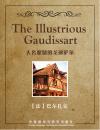"Have you observed, mademoiselle, that the painters and sculptors of the Middle Ages, when they placed two figures in adoration, one on each side of a fair Saint, never failed to give them a family likeness? When you here see your name among those that are dear to me, and under whose auspices I place my works, remember that touching harmony, and you will see in this not so much an act of homage as an expression of the brotherly affection of your devoted servant, "DE BALZAC."
For souls to whom effusiveness is easy there is a delicious hour that falls when it is not yet night, but is no longer day; the twilight gleam throws softened lights or tricksy reflections on every object, and favors a dreamy mood which vaguely weds itself to the play of light and shade. The silence which generally prevails at that time makes it particularly dear to artists, who grow contemplative, stand a few paces back from the pictures on which they can no longer work, and pass judgement on them, rapt by the subject whose most recondite meaning then flashes on the inner eye of genius. He who has never stood pensive by a friend's side in such an hour of poetic dreaming can hardly understand its inexpressible soothingness. Favored by the clear-obscure, the material skill employed by art to produce illusion entirely disappears. If the work is a picture, the figures represented seem to speak and walk; the shade is shadow, the light is day; the flesh lives, eyes move, blood flows in their veins, and stuffs have a changing sheen. Imagination helps the realism of every detail, and only sees the beauties of the work. At that hour illusion reigns despotically; perhaps it wakes at nightfall! Is not illusion a sort of night to the mind, which we people with dreams? Illusion then unfolds its wings, it bears the soul aloft to the world of fancies, a world full of voluptuous imaginings, where the artist forgets the real world, yesterday and the morrow, the future—everything down to its miseries, the good and the evil alike.
本书属于《人间喜剧》中私人生活场景的一部分。巴尔扎克在本书中探讨了一系列的主题,包括艺术,各种形式的创作,以及由此带来的酸甜苦辣。
From Lost Illusions. Scenes From Provincial Life from The Human Comedy (La Comedie Humaine). By the French author, who, along with Flaubert, is generally regarded as a founding-father of realism in European fiction. His large output of works, collectively entitled The Human Comedy (La Comedie Humaine), consists of 95 finished works (stories, novels and essays) and 48 unfinished works. His stories are an attempt to comprehend and depict the realities of life in contemporary bourgeois France. They are placed in a variety of settings, with characters reappearing in multiple stories.
- The Purse
- 书评 写书评
- 笔记
-
书评加载中...








20141029150519282424.jpg)
20141029150733785522.jpg)
201410291508528591159.jpg)
201410291509258711776.jpg)











 京公网安备 11010802032529号
京公网安备 11010802032529号
笔记加载中...